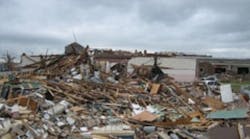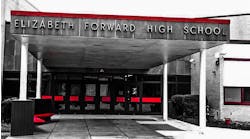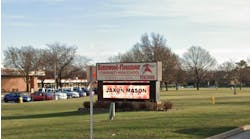Tornados damage and destroy schools every year, but many school designers and planners continue to propose new facilities that do not incorporate storm safety techniques. They often subscribe to the “it can't happen here” idea or argue that making schools safe is too expensive.
On the heels of two violent storms that damaged schools in 2007, education planners need to make sure they understand how to protect students by incorporating tornado shelters that are effective and affordable.
A reminder of the risk
Two storms this year serve as reminders that tornado safety is vital for schools. A March 2007 tornado in Enterprise, Ala., killed eight high school students — the largest death toll in a school tornado in many years. As the storm raced toward the town, school officials determined they didn't have time to carry out their emergency plan and send students home, and the deaths occurred when masonry from a collapsed interior corridor wall and the steel roof structure fell on students huddled in a corridor.
In May, an EF5 tornado — the most damaging level — in Greensburg, Kan., destroyed 95 percent of the town and killed 10 people. Schools were not in session, but there could have been dozens of injuries and deaths if the schools had been open.
About half of the continental United States is situated in 200 mph+ design wind load zone; the majority of this zone is east of the Continental Divide. Many planners believe that tornados occur only in Kansas, Oklahoma and Texas. On the contrary, 23 states have at least a portion of their population that lies within the 250 mph wind zone.
Schools generally are more prepared for other types of disasters than they are for tornados. For instance, schools threatened by hurricanes generally get several days of advance warning. And in some cases, schools in hurricane-prone areas are the designated community shelters and have been built to withstand a storm's wind and debris forces. Facilities in earthquake zones also are constructed to higher standards and often built as post-disaster recovery shelters. Schools threatened by flooding usually have advanced warning too, so students are not in the building when the waters rise. Moreover, fire safety for school facilities is stressed in both fire and model building codes.
So why do school planners often take tornado shelter design less seriously? In part, a number of myths and misperceptions exist about tornado safety planning.
Dispelling myths
However these myths and misperceptions got started, hard data and experience prove they are false and shortsighted. Among the most pervasive of these myths:
-
The chances of a school being directly hit by a tornado are not great enough to merit expensive safety measures. The Tornado Project has tracked how many tornados have hit schools and taken student lives, including 33 deaths in DeSoto, Ill., 25 deaths in Murphysboro, Ill., and 17 deaths in Commerce Landing, Miss. Other school tornado disasters in Oklahoma, Maryland, Virginia and Georgia killed more than 10 students each.
-
Schools already are safe places in a tornado. (School officials believe students will be protected by huddling in a school corridor, or they can leave the school before a tornado hits.) Unfortunately, the storm in Enterprise, Ala., reminds us that students do not always have the option to leave the school before a sudden storm.
-
State statutes and local building codes provide enough safeguards to ensure tornado safety in schools. Most schools were built before the latest guidelines and standards were adopted. In most cases, designated school tornado shelters designed or constructed prior to 2000 are sub-standard and actually may offer little, if any, protection. In addition, many that were designed in the last seven years that do not follow the FEMA 361 guidelines may be a death trap for students and staff.
-
Shelters are big concrete boxes that aren't used unless a storm approaches. Some school planners view building a storm shelter into a new school as a waste of money that could be better used elsewhere. They may think they will use the shelter only three times a year when a tornado drill is required. Without question, single-use shelters can be a tremendous waste of school resources, but clever facility design can ensure that tornado shelters are incorporated into effective educational spaces. To be cost-effective, shelters must be multi-use, used each day in the process of teaching and learning.
-
School tornado-safe areas must be in rooms without windows. In the past, even architects believed that the safest places in a tornado were interior corridors without windows, so they naturally wanted to build shelters without windows. On the other hand, school administrators know that having daylight in classrooms is beneficial. Fortunately, it is possible to design multi-use areas that have windows but are also safe in tornados. This represents a significant step forward in making tornado safety attractive to facility planners.
Proven safety measures
Education institutions are in a better position to plan for tornado shelters when they build new facilities or renovate older ones. It is imperative that architects and design teams understand and consider the dangers in their parts of the country and are up-to-date on the latest codes and design innovations. Tornado shelters go beyond normal design and construction methods and therefore should be considered a specialty. These are complicated systems with numerous nuances that must be dealt with correctly for the shelter to function properly when it is called upon to save lives.
Two sets of resources offer guidelines for school tornado shelters. The first, “Design and Construction Guidance for Community Shelters” (known as FEMA 361), is a guideline for community tornado shelters. Following these guidelines is mandatory for shelters that receive FEMA funding.
The second is a code standard, the International Code Council and National Storm Shelter Association ICC 500, scheduled to be released in January 2008. States and municipalities will have to adopt this code standard before it becomes mandatory. FEMA 361 already provides school planners with detailed standards for achieving the highest possible safety measures, providing “near absolute” protection, as should the ICC 500 when published.
Even schools that already have shelters should keep up with changing regulations. Scientists and meteorologists are learning more about why tornados form, how they can improve warning systems, and what could have prevented disasters that already have occurred.
In addition to incorporating the latest safety standards into their own buildings, school officials have an opportunity to push for higher standards for their communities. States receive federal funding that can be used to construct residential or community tornado shelters. Some school districts have incorporated community shelters into new school facilities, reducing the cost to the school district while enhancing community safety.
Schultz of PBA Architects, Wichita, Kan., is a member of the International Code Council/National Storm Shelter Association Consensus Committee on storm shelters developing code standards for shelter design. He was on the FEMA 361 review committee and the ICC 500 committee, and visited Greensburg, Kan., just days after the storm.
Lessons from Greensburg
This May, the first EF5 tornado on the National Weather Service's new enhanced-Fujita rating scale killed 10 people in Greensburg, Kan., and destroyed 95 percent of the town, including all the churches, downtown businesses and schools.
Greensburg did have areas designated as tornado shelters, as required by state law. Unfortunately, in some cases, these areas were interior corridors. Many of the interior corridors were covered in up to 4 feet of debris after the storm. If these areas were used for tornado shelters, up to three-fourths of students in these areas might have been killed.
Interior restrooms were designated shelter areas in the elementary school. If students had been sent to these locations, up to one-third of them might have been killed or seriously injured. About one-half of these fared well on the leeward side of the building, and the balance of the restrooms suffered major damage.
At the high school, the designated area under concrete bleachers in the gym fared pretty well. A basement may have kept students safe, but after the storm hit, it was filled with 2 inches of water and fallen ceiling tile. Even if students had avoided serious injury, recovery would have been impaired by debris that filled the stairwells.
23
Number of states that have at least a portion of their population that lies within the 250 mph wind zone.





